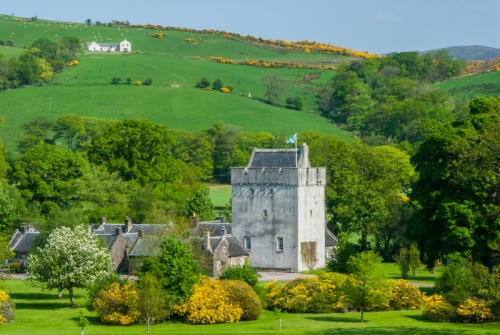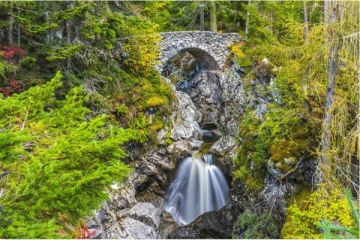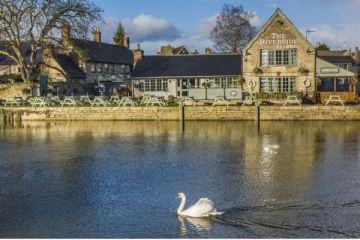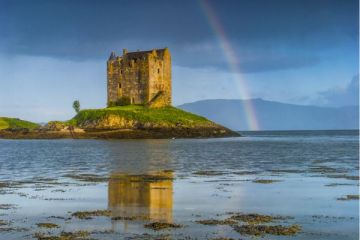
Kames Castle is a picturesque 16th-century fortified tower house on the edge of Port Bannatyne, Isle of Bute. The castle stands in 20 acres of grounds that include an 18th-century walled garden. Kames Castle is very likely one of the oldest houses in Scotland under continuous habitation.
The castle is surrounded by a number of stone cottages now, like the castle itself, converted to holiday lets.
The castle stands four storeys high and is built on a square plan. Two doors protect the only entrance, one wooden and the other made of iron. The parapet level is topped by a watchtower in one corner.
The castle was originally protected by a moat, but only traces of this remain today.
History
The origins of the Kames estate are obscure. One story you will frequently hear is that the lands were granted to the Bannatyne family by King Robert Bruce in gratitude for their support at the Battle of Bannockburn in 1314, however, there is no documentary evidence to support this story.
The estate takes its name from the Gaelic 'Camus', meaning a bay. The earliest castle here was probably built in the late 13th or early 14th century, but no records exist to verify the date or the builder.
The earliest known owners of Kames Castle were the Bannatyne family, sometimes spelled Bannachtyne or Ballatyne.
It appears that the Bannatynes acted as governors of the nearby town of Rothesay before it became a royal burgh and was given its own council. A charter of 1473 notes that the Burgesses of Rothesay accepted Ninian Bannatyne, Lord of Kames, as their master 'as their predecessors did to his ancestors', suggesting a longstanding connection between the Bannatyne family and the town. In 1475 King James III confirmed a grant of land at Kames to Ninian's son, Robert Bannatyne, for acting as a tutor to his son and heir, the future James IV.
Lord Bannatyne
A later Bannatyne represented the landowner of Bute at the signing of the National Covenant in 1647. The last Bannatyne owner of Kames Castle was Sir William Macleod Bannatyne (1743–1833), a successful Edinburgh lawyer who took the title Lord Bannatyne when he was raised to the College of Justice in 1799.
It was Lord Bannatyne who laid out the 2-acre walled garden in the castle grounds and added a luxurious residence abutting the tower house.
Lord Bannatyne clearly preferred life in Edinburgh, for in 1810 he sold the Kames estate to James Hamilton. The castle passed to the Marquess of Bute in 1863. The mansion built by Lord Bannatyne was pulled down in 1900, and in its place, the stone cottages that you see today were added.
The castle was used briefly as a holiday home for special-needs children under the care of a charity, but it is now in private ownership once more. The early 20th-century cottages are available as holiday lets. The castle is not generally open to visitors (unless you fancy a stay in one of the cottages), but the tower house is very easy to see from the A844, just west of Port Bannatyne on the way to Ettrick Bay.
Note: Do not confuse Kames Castle with Wester Kames Castle, 500m to the north. Wester Kames Castle was built around 1700 and was home to the Spence family for many years. It was in a ruinous state by the late Victorian period and was rebuilt in 1897 by the 3rd Marquess of Bute.
Getting There
From Port Bannatyne take the A844 signposted Ettrick Bay. You will a gatehouse lodge immediately beside the road junction, and a gated drive just past the lodge. Unless you are renting a holiday cottage, you will have to carry on up the A844 to the top of the hill, where the view opens out to the north and you can see Kame Castle clearly, rising above the stone-built cottages.
There is no layby, but it is fairly easy to pull off onto the verge for a good view. If you are on foot, there is a pedestrian pavement all the way up the hill.


